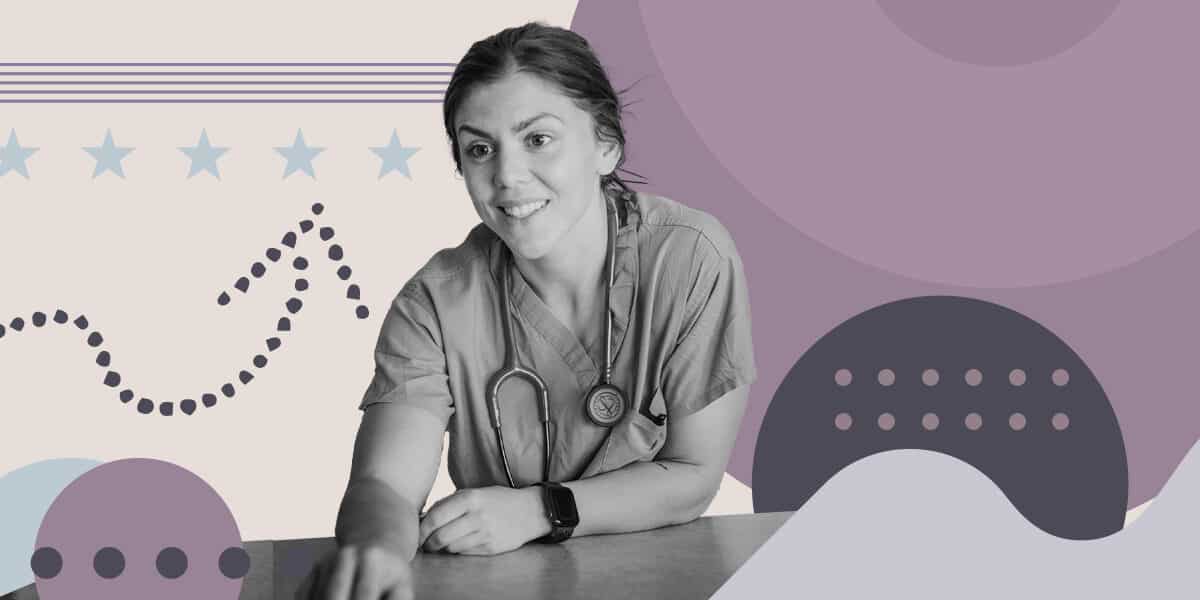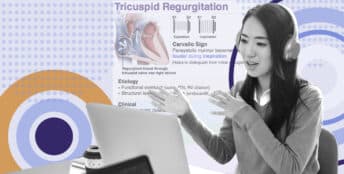Tips for Communicating with Patients During Residency

Starting day one of your residency, patients and attendings will have certain expectations of you. As a resident, it is crucial that you are proficient in communication to retrieve clinical questions in caring for patients, relay this to your attendings, and use evidence that will be used to address said medical concerns.
Of course, skillfully communicating with patients is easier said than done. Read on for strategies to improve your communication abilities and tackle this side of your clinical duties with confidence.
The Importance of Skillful Patient Communication
Having social awareness and assessing applicability to patients in regard to the clinical context is important, as is having the self-awareness to identify gaps and fill them.
The following are key skills to learn in residency and carry forward into your practice:
- Communicating medical findings and delivering difficult news to the patients and the rest of the healthcare team
- Closing the loop of physician-patient communication
- Reflecting and improving on the process to better patient outcomes
No matter which year you are in training, take this time to brush up on your communication skills so you can make the best connections with your patients.
Below is an example of a resident working a typical day in clinical practice, performing a particularly lengthy patient encounter. Read through it, formulate your thoughts, then read on for some additional commentary. See if you came to the same conclusions and reflect on how you would behave differently.
A Clinical Case Study
Let’s begin with a clinical vignette of what a typical resident may encounter during their shift. We’ll also run through highlights of clinical/interpersonal skills that are important for residents to master early on.
The Assignment
Trinity is a PGY-1 on the infectious disease hospital service and receives a consult on her pager. She speaks to the medical team that placed the consult and confirms that she is needed to help care for an immunocompromised patient with a recent diagnosis of invasive aspergillosis while he is hospitalized. Particularly, the team is asking for her thoughts on the initiation of Amphotericin in treatment, dosage, duration, etc, given the patient’s decreased kidney function.
Initial Meeting with the Patient
Trinity reads through the patient’s medical chart including labs, imaging, and hospital course to date. She then goes to the floor to see and examine the patient. Trinity reviews her findings and prepares to present to her attending, but is held up by the patient and the patient’s wife, who seem anxious and have various questions, some of which she has a hard time answering.
The patient looks down at his feet and sheepishly whispers that the primary team mentioned that the disease is most commonly sexually transmitted, which has caused a rift of distrust and animosity between the patient and his spouse. Furthermore, the pair want to know if the treatment is definitive and will cure the disease.
Additional Research & Communication
Trinity is not familiar with the specific treatment criteria for invasive aspergillosis, so she goes to an online evidence summary source for reference.
While reviewing the treatment modalities, she finds that there are different cases of aspergillosis in immunocompromised patients, as well as a well-documented treatment plan. Trinity reviews the electronic medical record in more detail, paying particular attention to the data she has read that will help differentiate the diagnosis to better answer the patient’s question.
Seeing that some of the necessary information is not included in the chart notes, Trinity goes back to gather a more thorough history, using open-ended questions, from the patient and his wife to round out a more complete exam. By taking this extra time, she identifies the cause of the patient’s immunosuppression: the patient has been taking long-term steroids for a rheumatologic issue.
Trinity explains this fact, which eases the tension between the patient and his wife. They are very appreciative that you have cleared this up. Trinity nods and tells the patient that she has all of the information she needs to discuss the case with her attending physician.
Presenting the Case to Her Team
In the team room, Trinity, after gathering a complete history and physical, is ready to present the case and develop a treatment plan with her attending. When prompted by the attending for her assessment, she outlines a differential and discusses patient-specific reasons for or against each case. She includes relevant information such as imaging, labs, clinical course so far, as well as the cause of the patient’s immunocompromised status.
The attending physician then joins the discussion and asks what Trinity thinks they should do next for the patient. Trinity states that based on her reading, amphotericin should be initiated given the patient’s immune status, and the likelihood of the diagnosis given the positive culture of the organism, in combination with evidence of tissue invasion on histopathology which provides further evidence of invasive aspergillosis.
Going Back to the Drawing Board
The attending nods and commends Trinity for the information she has gathered, but counters with a different treatment modality. Trinity is instructed to do some further reading into the choice of treatment for invasive aspergillosis in hospitalized patients. She returns shortly after to complete her presentation and suggests an initial monotherapy course of Voriconazole.
Trinity reports from her literature search that there is strong and consistent evidence from randomized controlled trials for using voriconazole monotherapy for cases like this, reserving amphotericin for severe or resistant cases. The attending physician agrees and confirms the resident’s recommendations.
Final Discussions with the Patient
They inform the patient and complete the visit as a team, addressing the patient’s questions in layman’s terms, providing handouts regarding the use of long-term steroids, what it means to be immunocompromised, as well as handouts for invasive aspergillosis and side effects of using -azole drugs.
The patient and his wife thank their medical team for the thorough plan. Trinity informs the medicine team that placed the consult, who are on board with the plan. She then writes in her medical journal and documents her case findings, reflecting on the positives and negatives of today’s patient encounters.
Reflection: How Did Trinity Do?
Some highlights of Trinity’s hospital consult: How did she do? What did she do well and what can you learn from this visit?
Trinity did an amazing job with communication and was very receptive to feedback from her attending. Overall, the patient is pleased with the encounter as he received clarification of his diagnosis as well as a decisive treatment plan. The attending is impressed by Trinity’s thorough history.
Although she had an overly aggressive initial treatment plan, she was willing to update it to a more reasonable approach. (If I’m allowed to nitpick, I would suggest that she confirms the patient’s understanding of the situation by asking him follow-up questions.)
6 Communication Tips for Residents
Some tips Trinity used in her patient encounter that any clinician should incorporate into their arsenal:
1. First impressions matter.
The first few minutes of a clinical encounter can set the tone for the remainder of the visit.
There are many tasks that need to be completed during the visit—questions to ask, medications to reconcile, and concerns to address (physician concerns and patient concerns). All of this needs to be done in a relatively short time frame, so you may feel pressured to dive in head first. Don’t. Be sure to give a proper introduction and listen carefully to the patient’s concerns so as to not miss vital information.
Ensure that you give your full attention to the patient and show them you are their priority. Furthermore, don’t forget to dress professionally and arrive on time. These basic best practices are essential steps to show that you are engaged, organized, and ready to address the patient’s needs.
Finally, remember to review the patient’s chart beforehand, especially if they have a complicated medical history. Enter the visit prepared and address the patient by their name. This is the first step in building rapport and patient trust.
2. Adapt to nonverbal cues.
Nonverbal communication can be as important as the actual words a clinician uses during their interaction with the patient. Body posture, gestures, and eye contact can all combine with verbal communication to facilitate meaningful positive communication with your patient.
Pay attention to any nonverbal cues your patients may display. Some patients are simply shy and look away while addressing the physician. This is very different from avoiding the question or the physician entirely. Context matters, particularly in pediatric and geriatric cases—is the patient timid and looks to a parent/caregiver for confirmation, or is the patient normally talkative but avoids certain questions and looks at a parent in fear of saying too much?
Keep a concern for abuse in the back of your mind and correlate this clinically. Bruises, frequent hospital visits, and multiple bone fractures can be telltale signs. Nonverbal cues can include eye movement and aversion, restlessness, and facial expressions of discomfort.
By the same token, pay attention to your nonverbal communication. Be open and avoid crossed arms, sit close to your patient, and speak clearly in order to convey confidence and establish trust.
3. Ask the right questions.
What kind of questions should you be asking your patient to understand their situation and forge a path forward together?
For starters, use open-ended questions when appropriate. This is the preferred technique during patient interviews as it allows the patient to provide their unique and in-depth responses.
Open-ended questions do not limit the patient to binary responses such as “yes” or “no” and encourage patients to disclose more information. Additionally, open-ended questions require the patient to describe his concerns and yield specific information pertaining to that visit.
It can be an art to extract useful information from the interview with these open-ended questions. Be alert and ready to redirect the patient if they wander too far on a tangent.
4. Strike a balance between listening and speaking.
How do you find a balance between speaking and listening to make sure you understand your patient’s situation, while also making sure they understand their diagnosis/treatment?
First and foremost, prepare and enter the visit with a plan. This includes preemptively coming up with answers to frequently asked questions.
Interactions with patients can be challenging. Every patient, resident, and attending has had suboptimal visits often caused by misunderstandings or lack of preparation. Use the communication and listening skills learned from this post for future consultations.
In particular, focus on asking what you need to know to address the patient’s concerns. Listen and allow time for questions when the patient describes their concerns. Give your patient room to elaborate on and ask questions about their concerns and answer in a clear manner, avoiding difficult medical lingo unless necessary.
5. Use understandable, clear language.
How does the language you use affect a patient’s experience? For one thing, the wrong language, such as highly-academic language, can create confusion and frustration. To prevent this, avoid technical terms and speak clearly and directly.
Often, healthcare professionals assume that patients and families understand what they’ve been told, but a simple nod does not equate to comprehension. Ask patients to voice their understanding and allow ample time for questions or clarification.
Choose appropriate, inclusive language that will not offend and be socially aware. It is important to break down information into digestible pieces and ensure the patient has a clear understanding before moving forward with the conversation.
Finally, close the loop by making sure the patient understands. Do so by asking them to summarize what you have mentioned so far. This allows both patient and clinician to be on the same page during the visit.
6. Create the right environment for difficult conversations.
What are some unique patient scenarios you might experience as a resident? Well, one tough scenario for any clinician is when you have to deliver bad news, such as a life-changing diagnosis.
Be sure to do so in a proper setting—private, quiet, preferably with two chairs so you can sit down with the patient. Then, ask the patient what their understanding of the situation is so far. Moreover, ask the patient what and how much they would like to know.
Provide this information in small pieces. Speak clearly and concisely. Do not sugarcoat or exaggerate the diagnosis. All the while, be mindful to acknowledge the patient’s emotions during this stressful time. Make sure to show empathy and provide support for your patient and always allow time for questions.
Make a plan of action for further diagnosis and management. It is ideal for patients to be prepared and to participate in the treatment decision-making process rather than to be kept in the dark.
Consider the role of the patient’s partner or caregiver during the consultation. This may be the patient’s spouse, parent, or friend who can help support the patient during the visit. Acknowledge this person as they will have their own questions or concerns, which should be addressed.
Being able to carry out these kinds of conversations is a constant learning process, so be mindful of each difficult interaction you have and reflect on each to see what went well and what did not.
Wrapping Up & Additional Resources
Patient interactions can be difficult as a resident, and some will surely be difficult even when you are an attending physician. Remember to listen intently, communicate openly, and offer reassurance and support when appropriate.
Keep an eye out for signs of anger or distress and steer the conversation in the direction that is best for the patient. If issues arise, search for the misunderstanding and look for common ground. Lastly, reflect on your patient visits to further hone your skills.
With enough practice, you’ll be well on your way to communicating with ease as you make your rounds. But why stop there? Explore these other free guides on the Rosh Review blog to ensure that all aspects of your residency experience go as smoothly as possible:
- The Key to Teaching & Learning Procedures as a Resident
- How to Survive a 24-Hour Shift During Your Medical Residency
- Medical Residency Burnout: How to Avoid It
- 3 Ways to Make Extra Money During Residency
Rosh Review is a board review company providing Qbanks that boost your confidence for your boards and beyond. Get started with a Rosh Review free trial to the Qbank of your choice (no credit card required!) and gain access to board-style practice questions, detailed explanations, beautiful medical images, and more.
Get Free Access and Join Thousands of Happy Learners





Comments (0)